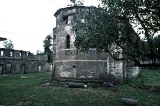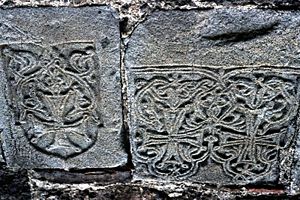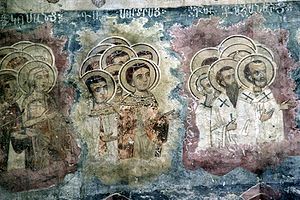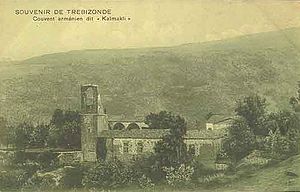
Kaymakli Monastery
Encyclopedia
Kaymaklı Monastery is a ruined Armenian Apostolic
monastery near Trabzon
, Turkey
.
The monastery originally included a church, a bell tower
at the northwest corner, and a small chapel
near the southeast corner.
, three kilometres southeast of Trabzon
(40.9943°N 39.74418°W). The site overlooks the Değirmendere Valley, the ancient river Pyxites, along which runs the main trade route into eastern Anatolia and beyond.
An Armenian community existed in Trabzon
as early as the 7th century. During the Mongol invasions
of the 13th and 14th centuries, numerous Armenian families fled here from Ani
. However, exact date of the monastery's foundation and origin remains unclear. A religious community was present at the site from at least the fifteenth century, and possibly as early as the eleventh. The oldest structure in the compound is dated to 1424. In 1461 it was pillaged and destroyed by Turks. In the 16th century, the rebuilt monastery became a center of Armenian manuscript production
.
It was named Ամենափրկիչ Վանք (Amenaprgič Vank) in Armenian, which translates as "Monastery of the All-Saviour". The Ottoman Sultan Murad III
is said to have eaten a meal at the monastery consisting only of dairy products. He confirmed the monastery's possession of its lands, and the place came to be called in Turkish Kaymaklı, meaning "with/of kaymak
", in memory of the occasion. Previously it had been called Yesil Manastir - the Green Monastery.
 The site was a terrace enclosed by a wall 30 x 40m. The wall is now almost completely destroyed. The oldest surviving structure is a small chapel located at the eastern end of the compound. According to an inscription above the door, it was built in 1424 by prince Hodja Stephanos Shemsedli (Khoja Stepanos Shemsedin). The chapel has reused khachkars in its walls. The original complex included a zhamatun, fountain known as the milk fountain, a tower, the mentioned chapel, and an arcaded monastic building.
The site was a terrace enclosed by a wall 30 x 40m. The wall is now almost completely destroyed. The oldest surviving structure is a small chapel located at the eastern end of the compound. According to an inscription above the door, it was built in 1424 by prince Hodja Stephanos Shemsedli (Khoja Stepanos Shemsedin). The chapel has reused khachkars in its walls. The original complex included a zhamatun, fountain known as the milk fountain, a tower, the mentioned chapel, and an arcaded monastic building.
 The main church is rectangular in form, with three naves
The main church is rectangular in form, with three naves
and three apses. The main apse is pentagonal. The founding date for the church is not clear, but is believed to have been built on a surviving parts of a 12-13th century Greek church on the site. The original roof of the main church was made of timber and had fallen-in by 1929. In 1961 a replacement roof, also made of timber, was installed when the church began to be used as a barn. This roof is also now gone, and it is unclear whether the church is currently roofed. There was a narthex
or zhamatun at the western end of the church, but it has entirely disappeared.
The inside of the church is decorated with elaborate fresco
es showing various biblical scenes. They are believed to have been painted in the 17-18th centuries. On the west wall is a large fresco on three sections depicting the Last Judgment
. North-west of the church are the remains of a bell tower
, once an extremely tall structure. South of the church are the remains of a 2-story monastic building that had a portico
with stone columns on the lower floor.
 Until 1915 it served as the seat of the Trebizond diocese tied to the Armenian Patriarchate of Constantinople
Until 1915 it served as the seat of the Trebizond diocese tied to the Armenian Patriarchate of Constantinople
. At this time, the vibrant Armenian community of the city numbered 30,000. In 1915, the normal functions of the monastery were interrupted when it was used as a transit camp for Armenians being deported to Syria
during the Armenian Genocide
. After the Russian capture of Trebizond
, Armenian monks returned to the monastery, and monks were there until sometime after World War I
, supposedly 1923.
A fire may have partially ruined the site at a later date. By the 1950s, the main church was roofless and most of the bell-tower had been destroyed. A farm now utilizes the remaining buildings of the Kaymaklı monastery.
Armenian Apostolic Church
The Armenian Apostolic Church is the world's oldest National Church, is part of Oriental Orthodoxy, and is one of the most ancient Christian communities. Armenia was the first country to adopt Christianity as its official religion in 301 AD, in establishing this church...
monastery near Trabzon
Trabzon
Trabzon is a city on the Black Sea coast of north-eastern Turkey and the capital of Trabzon Province. Trabzon, located on the historical Silk Road, became a melting pot of religions, languages and culture for centuries and a trade gateway to Iran in the southeast and the Caucasus to the northeast...
, Turkey
Turkey
Turkey , known officially as the Republic of Turkey , is a Eurasian country located in Western Asia and in East Thrace in Southeastern Europe...
.
The monastery originally included a church, a bell tower
Bell tower
A bell tower is a tower which contains one or more bells, or which is designed to hold bells, even if it has none. In the European tradition, such a tower most commonly serves as part of a church and contains church bells. When attached to a city hall or other civic building, especially in...
at the northwest corner, and a small chapel
Chapel
A chapel is a building used by Christians as a place of fellowship and worship. It may be part of a larger structure or complex, such as a church, college, hospital, palace, prison or funeral home, located on board a military or commercial ship, or it may be an entirely free-standing building,...
near the southeast corner.
Location, founding and name
The monastery is located on top of Boztepe hillBoztepe hill, Trabzon
Boztepe or Mount Minthrion is a hill near Trabzon in Turkey.It is located 3 kilometers southeast of the city center of Trabzon. The Değirmendere Valley lies to the west of Boztepe...
, three kilometres southeast of Trabzon
Trabzon
Trabzon is a city on the Black Sea coast of north-eastern Turkey and the capital of Trabzon Province. Trabzon, located on the historical Silk Road, became a melting pot of religions, languages and culture for centuries and a trade gateway to Iran in the southeast and the Caucasus to the northeast...
(40.9943°N 39.74418°W). The site overlooks the Değirmendere Valley, the ancient river Pyxites, along which runs the main trade route into eastern Anatolia and beyond.
An Armenian community existed in Trabzon
Trabzon
Trabzon is a city on the Black Sea coast of north-eastern Turkey and the capital of Trabzon Province. Trabzon, located on the historical Silk Road, became a melting pot of religions, languages and culture for centuries and a trade gateway to Iran in the southeast and the Caucasus to the northeast...
as early as the 7th century. During the Mongol invasions
Mongol invasions
Mongol invasions progressed throughout the 13th century, resulting in the vast Mongol Empire which covered much of Asia and Eastern Europe by 1300....
of the 13th and 14th centuries, numerous Armenian families fled here from Ani
Ani
Ani is a ruined and uninhabited medieval Armenian city-site situated in the Turkish province of Kars, near the border with Armenia. It was once the capital of a medieval Armenian kingdom that covered much of present day Armenia and eastern Turkey...
. However, exact date of the monastery's foundation and origin remains unclear. A religious community was present at the site from at least the fifteenth century, and possibly as early as the eleventh. The oldest structure in the compound is dated to 1424. In 1461 it was pillaged and destroyed by Turks. In the 16th century, the rebuilt monastery became a center of Armenian manuscript production
Armenian illuminated manuscript
Armenian illuminated manuscripts form a separate tradition, related to other forms of Medieval Armenian art, but also to the Byzantine tradition. The earliest surviving examples date from the Golden Age of Armenian art and literature in the 5th century...
.
It was named Ամենափրկիչ Վանք (Amenaprgič Vank) in Armenian, which translates as "Monastery of the All-Saviour". The Ottoman Sultan Murad III
Murad III
Murad III was the Sultan of the Ottoman Empire from 1574 until his death.-Biography:...
is said to have eaten a meal at the monastery consisting only of dairy products. He confirmed the monastery's possession of its lands, and the place came to be called in Turkish Kaymaklı, meaning "with/of kaymak
Kaymak
Kaymak ; also kaymak, kajmak, kaimak or qeymağ, also geymar, gaimar, is a originally Serbian creamy dairy product, similar to clotted cream, made in Serbia, Turkey,...
", in memory of the occasion. Previously it had been called Yesil Manastir - the Green Monastery.
Buildings

Main church

Navès
Navès is a commune in the Tarn department in southern France.-Geography:The Thoré forms most of the commune's north-eastern border, then flows into the Agout, which forms part of its northern border.-References:*...
and three apses. The main apse is pentagonal. The founding date for the church is not clear, but is believed to have been built on a surviving parts of a 12-13th century Greek church on the site. The original roof of the main church was made of timber and had fallen-in by 1929. In 1961 a replacement roof, also made of timber, was installed when the church began to be used as a barn. This roof is also now gone, and it is unclear whether the church is currently roofed. There was a narthex
Narthex
The narthex of a church is the entrance or lobby area, located at the end of the nave, at the far end from the church's main altar. Traditionally the narthex was a part of the church building, but was not considered part of the church proper...
or zhamatun at the western end of the church, but it has entirely disappeared.
The inside of the church is decorated with elaborate fresco
Fresco
Fresco is any of several related mural painting types, executed on plaster on walls or ceilings. The word fresco comes from the Greek word affresca which derives from the Latin word for "fresh". Frescoes first developed in the ancient world and continued to be popular through the Renaissance...
es showing various biblical scenes. They are believed to have been painted in the 17-18th centuries. On the west wall is a large fresco on three sections depicting the Last Judgment
Last Judgment
The Last Judgment, Final Judgment, Day of Judgment, Judgment Day, or The Day of the Lord in Christian theology, is the final and eternal judgment by God of every nation. The concept is found in all the Canonical gospels, particularly the Gospel of Matthew. It will purportedly take place after the...
. North-west of the church are the remains of a bell tower
Bell tower
A bell tower is a tower which contains one or more bells, or which is designed to hold bells, even if it has none. In the European tradition, such a tower most commonly serves as part of a church and contains church bells. When attached to a city hall or other civic building, especially in...
, once an extremely tall structure. South of the church are the remains of a 2-story monastic building that had a portico
Portico
A portico is a porch leading to the entrance of a building, or extended as a colonnade, with a roof structure over a walkway, supported by columns or enclosed by walls...
with stone columns on the lower floor.
Modern times

Armenian Patriarchate of Constantinople
The Armenian Patriarchate of Constantinople , one of the smallest Patriarchates of the Oriental Orthodox Church but one that has exerted a very significant political role and today still exercises a spiritual authority....
. At this time, the vibrant Armenian community of the city numbered 30,000. In 1915, the normal functions of the monastery were interrupted when it was used as a transit camp for Armenians being deported to Syria
Syria
Syria , officially the Syrian Arab Republic , is a country in Western Asia, bordering Lebanon and the Mediterranean Sea to the West, Turkey to the north, Iraq to the east, Jordan to the south, and Israel to the southwest....
during the Armenian Genocide
Armenian Genocide
The Armenian Genocide—also known as the Armenian Holocaust, the Armenian Massacres and, by Armenians, as the Great Crime—refers to the deliberate and systematic destruction of the Armenian population of the Ottoman Empire during and just after World War I...
. After the Russian capture of Trebizond
Trebizond Campaign
The Trebizond Campaign, also known as the Battle of Trebizond was a series of brilliant Russian naval and land operations that resulted in the capture of Trebizond. It was the logistical step after the Erzerum Campaign. Operations began on February 5 and concluded when the Ottoman troops abandoned...
, Armenian monks returned to the monastery, and monks were there until sometime after World War I
World War I
World War I , which was predominantly called the World War or the Great War from its occurrence until 1939, and the First World War or World War I thereafter, was a major war centred in Europe that began on 28 July 1914 and lasted until 11 November 1918...
, supposedly 1923.
A fire may have partially ruined the site at a later date. By the 1950s, the main church was roofless and most of the bell-tower had been destroyed. A farm now utilizes the remaining buildings of the Kaymaklı monastery.
See also
- Hagia Sophia cathedral of TrabzonHagia Sophia, TrabzonThe church of Hagia Sophia , now the Hagia Sophia Museum, is a former Chalcedonian church located in the city of Trabzon in the north-eastern part of Turkey. It dates back to the 13th century when Trabzon was the capital of the Empire of Trebizond. It is located near the seashore and 2 miles west...
- Kuştul MonasteryKustul MonasteryKuştul Monastery is located near Şimşirli village, Maçka district, Trabzon Province, Turkey. Founded in 752 CE at 30 km southeast of Trabzon, it was finally closed on January 17, 1923, when the monks along with other Greeks were expelled to Greece. After 1906 fire, it was restored...
- Sümela MonasterySumela MonasteryThe Sümela Monastery , , i.e. monastery of the Panaghia at Melá mountain) is a Greek Orthodox monastery, standing at the foot of a steep cliff facing the Altındere valley, in the region of Maçka in Trabzon Province, modern Turkey...

